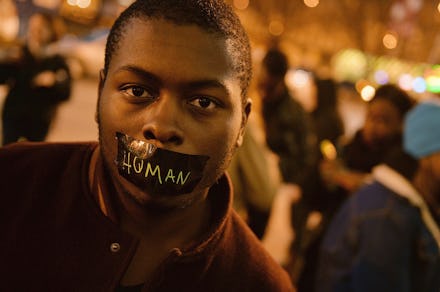Why We Need to Stop Talking About the "Magical Negro"

The "Pass the Mic" series showcases voices, perspectives and ideas that spark interesting conversations.
Just as recent national protests of police killings of unarmed blacks inform the unaware that black lives matter, the details surrounding these deaths have made it crystal clear that perceptions matter when fear colors the white imagination and black life hangs in the balance. Officer Darren Wilson, for example, claims to have been in the grips of a "black demon" with the strength of "Hulk Hogan" when he shot and killed Mike Brown in Ferguson, Missouri. Seeing blackness as evil shadows, demons or writhing savage beasts has become the picture that too many continue to paint in their minds when they "see" young black and brown women and men.
The first step in confronting and eradicating racial bias in America (and the dire consequences attached to it) is to acknowledge that it actually exists. I've experienced this bias firsthand. Too many times to count, I've been perceived as the spook in the hallways and offices of the ivory tower. As a literary scholar and professor of black studies, I expect these minor incidents; yet I also turn to the same body of literature I teach for reflection about some of the deeper issues at work in the recent spate of state-sanctioned murders, as it offers critical keys to unlocking the mystifying persistence of racial bias.
In her brilliant short story "The Magical Negro," Nnedi Okorafor dissects the mythology that underwrites a prominent stock character in the white American imagination: the superhumanized black person. Popular film portrayals of the figure include Will Smith in The Legend of Bagger Vance and Michael Clarke Duncan in The Green Mile, among many others. But this figure's ongoing presence in our collective imagination reaches beyond the pages of fiction or the movie theater.
For too many Americans, the Magical Negro is real, and recent research on superhumanization bias suggests that the magical abilities ascribed to black folks can have deadly consequences. In an article on the topic, researchers Adam Waytz, Kelly M. Hoffman and Sophie Trawalter write that "a subtler form of dehumanization of blacks persists [that] increases endorsement of police brutality against blacks ... and reduces altruism toward blacks." According to their research, this superhumanization bias shapes white people's perceptions of black people.
Okorafor's "The Magical Negro" opens with Lance the Brave, a sword-wielding, long-haired, blue-eyed hero, standing on the precipice of a cliff as dark shadows pursue him. "The shadows were savage beasts," Okorafor writes. "The horrible black things were known to skin a man alive, tear off his fingernails one by one, boil a man's flesh until it fell apart. The shadows would dirty his very soul. The shadows came from the very heart of darkness." Okorafor's heavy-handed allusions to Joseph Conrad's classic, and classically racist, novel Heart of Darkness situates the Magical Negro figure within the history of black imagery as the evil other in the white imagination.
It's a picture that too many continue to paint in their minds when they "see" young people of color.
When attempting to handcuff Oscar Grant before shooting him in the back on the platform of the Fruitvale station, what did BART police Officer Johannes Mehserle "see?" What did the Cleveland officers "see" when they "took down" Tanisha Anderson, smashing her head on the concrete, ultimately killing her and exposing her naked lower body?
A 2012 study conducted by the Malcolm X Grassroots Movement found that a black person was a victim of an extrajudicial killing — defined as "killing by police that happens without trial or any due process" — every 28 hours. "When a police officer kills one of us, it is an execution in the street," the report states. Do these officers allow their indoctrinated imaginations to color their abilities to perceive some people's humanity? Perceptions matter. And the perception that black people are more than human allows law enforcement to treat them as less than human.
Perceptions matter. And the perception that black people are more than human allows law enforcement to treat them as less than human.
Many scholars argue that the real culprit in these unjustified murders is systemic — the carceral state itself. They argue that our true struggle is against a nation-state drunk off of decades of Law and Order-style policing, prison privatization, a failed "war on drugs" and a full slate of neoliberal policies designed to contain, surveil, incarcerate and impoverish large swaths of poor and working-class communities of color. I don't disagree with them.
But the battle must be fought on multiple fronts. One way to contend against these forces on the edges of the carceral state is to eradicate racial superhumanization biases, particularly when they become weapons of the state and its penchant for sustaining institutional injustice.
At the conclusion of Okorafor's short story, the Magical Negro figure chides readers for being wedded to his superhuman subservient characterization for so long and then sets out on what will presumably be adventures of his own. It's a humorous and rewarding ending, and it reflects Okorafor's own disgust with this figure in literary worlds. But in reality, I'd be much happier with an ending wherein the superhuman Magical Negro were slain forever — erased from the minds of those who see us as more than we are in order that they might make us less than we are.
This essay is part of the "Shifting Perceptions: Being Black in America" series commissioned by the Perception Institute.